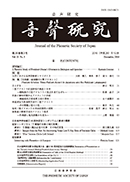14 巻, 2 号
選択された号の論文の24件中1~24を表示しています
- |<
- <
- 1
- >
- >|
表紙
-
原稿種別: 表紙
2010 年14 巻2 号 p. Cover1-
発行日: 2010/08/30
公開日: 2018/03/31
PDF形式でダウンロード (531K)
研究論文
-
原稿種別: 本文
2010 年14 巻2 号 p. 1-15
発行日: 2010/08/30
公開日: 2017/08/31
PDF形式でダウンロード (11413K)
研究ノート
-
原稿種別: 本文
2010 年14 巻2 号 p. 16-24
発行日: 2010/08/30
公開日: 2017/08/31
PDF形式でダウンロード (7420K) -
原稿種別: 本文
2010 年14 巻2 号 p. 25-34
発行日: 2010/08/30
公開日: 2017/08/31
PDF形式でダウンロード (7129K)
特集「音声整理研究の方法」
-
原稿種別: 本文
2010 年14 巻2 号 p. 35-36
発行日: 2010/08/30
公開日: 2017/08/31
PDF形式でダウンロード (1627K) -
原稿種別: 本文
2010 年14 巻2 号 p. 37-44
発行日: 2010/08/30
公開日: 2017/08/31
PDF形式でダウンロード (6755K) -
原稿種別: 本文
2010 年14 巻2 号 p. 45-56
発行日: 2010/08/30
公開日: 2017/08/31
PDF形式でダウンロード (9836K) -
原稿種別: 本文
2010 年14 巻2 号 p. 57-64
発行日: 2010/08/30
公開日: 2017/08/31
PDF形式でダウンロード (6981K) -
原稿種別: 本文
2010 年14 巻2 号 p. 65-77
発行日: 2010/08/30
公開日: 2017/08/31
PDF形式でダウンロード (12399K)
第321回研究例会発表要旨
-
原稿種別: 本文
2010 年14 巻2 号 p. 78-
発行日: 2010/08/30
公開日: 2018/03/31
PDF形式でダウンロード (206K) -
原稿種別: 本文
2010 年14 巻2 号 p. 78-
発行日: 2010/08/30
公開日: 2018/03/31
PDF形式でダウンロード (206K) -
原稿種別: 本文
2010 年14 巻2 号 p. 78-79
発行日: 2010/08/30
公開日: 2018/03/31
PDF形式でダウンロード (1311K) -
原稿種別: 本文
2010 年14 巻2 号 p. 79-
発行日: 2010/08/30
公開日: 2018/03/31
PDF形式でダウンロード (110K)
第24回日本音声学会全国大会
-
原稿種別: 付録等
2010 年14 巻2 号 p. 80-85
発行日: 2010/08/30
公開日: 2018/03/31
PDF形式でダウンロード (411K)
会務報告
-
原稿種別: 付録等
2010 年14 巻2 号 p. 100-103
発行日: 2010/08/30
公開日: 2018/03/31
PDF形式でダウンロード (3185K)
奥付
-
原稿種別: 付録等
2010 年14 巻2 号 p. 104-
発行日: 2010/08/30
公開日: 2018/03/31
PDF形式でダウンロード (499K)
お知らせ
-
原稿種別: 付録等
2010 年14 巻2 号 p. 90-
発行日: 2010/08/30
公開日: 2018/03/31
PDF形式でダウンロード (63K) -
原稿種別: 付録等
2010 年14 巻2 号 p. 98-
発行日: 2010/08/30
公開日: 2018/03/31
PDF形式でダウンロード (38K) -
原稿種別: 付録等
2010 年14 巻2 号 p. 99-
発行日: 2010/08/30
公開日: 2018/03/31
PDF形式でダウンロード (75K) -
原稿種別: 付録等
2010 年14 巻2 号 p. 104-
発行日: 2010/08/30
公開日: 2018/03/31
PDF形式でダウンロード (499K) -
原稿種別: 付録等
2010 年14 巻2 号 p. 104-
発行日: 2010/08/30
公開日: 2018/03/31
PDF形式でダウンロード (499K) -
原稿種別: 付録等
2010 年14 巻2 号 p. 104-
発行日: 2010/08/30
公開日: 2018/03/31
PDF形式でダウンロード (499K) -
原稿種別: 付録等
2010 年14 巻2 号 p. App4-
発行日: 2010/08/30
公開日: 2018/03/31
PDF形式でダウンロード (74K) -
原稿種別: 付録等
2010 年14 巻2 号 p. App5-
発行日: 2010/08/30
公開日: 2018/03/31
PDF形式でダウンロード (74K)
- |<
- <
- 1
- >
- >|
